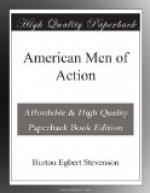Instant disaster followed. When he left the colony, it numbered five hundred souls; when the next supply ship reached it in May, 1610, it consisted of sixty scarecrows, mere wrecks of human beings. The rest had starved to death—or been eaten by their companions! There was a hasty consultation, and it was decided that Virginia must be abandoned. On Thursday, June 7, 1610, the cabins were stripped of such things as were of value, and the whole company went on shipboard and started down the river—only to meet, next day, in Hampton Roads, a new expedition headed by the new governor, Lord Delaware, himself! By this slight thread of coincidence was the fate of Virginia determined.
The ship put about at once, and on the following Sunday morning, Lord Delaware stepped ashore at Jamestown, and, falling to his knees, thanked God that he had been in time to save Virginia. He proceeded at once to place the colony upon a new and sounder basis, and it was never again in danger of extinction, though Jamestown itself was finally abandoned as unsuited to a settlement on account of its malarious atmosphere. But Virginia itself grew apace into one of the greatest of England’s colonies in America.
John Smith himself never returned to Virginia. In 1614, he explored the coast south of the Penobscot, giving it the name it still bears, New England. A year later, while on another expedition, he was captured by the French and forced to serve against the Spaniards. Broken in health and fortune, he spent his remaining years in London, dying there in 1631. There is a portrait of him, showing him as a handsome, bearded man, with nose and mouth bespeaking will and spirit—just such a man as one would imagine this gallant soldier of fortune to have been.
While the English, under the guiding hand of John Smith, were fighting desperately to maintain themselves upon the James, the French were struggling to the same purpose and no less desperately along the St. Lawrence. We have seen how Jacques Cartier explored and named that region, but civil and religious wars in France put an end to plans of colonization for half a century, and it was not until 1603 that Samuel Champlain, the founder of New France, and one of the noblest characters in American history, embarked for the New World.




